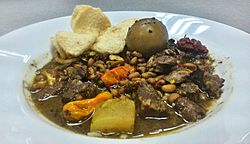Brongkos facts for kids

A plate of brongkos, a spicy Javanese meat and bean stew.
|
|
| Course | Main course |
|---|---|
| Place of origin | Indonesia |
| Region or state | Yogyakarta, Central Java |
| Serving temperature | Hot or room temperature |
| Main ingredients | Black-eyed pea, meat (beef, goat meat or mutton), palm sugar, chili, kluwek, various spices, coconut milk, egg |
Brongkos is a yummy and spicy stew from Java, Indonesia. It's a special dish from places like Yogyakarta and other cities in Central Java. This stew is packed with meat and beans! Don't mix up Brongkos with "brengkes," which is a different Javanese dish cooked in banana leaves.
Contents
What's in Brongkos?
Brongkos is made with small pieces of meat. This can be beef, goat meat, or mutton. It also has hard-boiled eggs and tofu. The stew includes beans, usually black-eyed peas or red kidney beans. You might also find diced chayote and sometimes carrots in it.
The Special Spices
The stew gets its rich flavor from coconut milk and many different spices. One key spice is black kluwek, which gives it a unique dark color. Other spices include lemongrass, kaffir lime leaves, and bay leaves. There's also salt and palm sugar. A special paste is made from ground galangal, kencur, ginger, coriander, shallots, and roasted candlenut. For those who like it extra hot, whole bird's eye chilies are added. Biting into one gives a surprising spicy kick!
How it's Served
Brongkos is often served with steamed rice. This combination is called nasi brongkos, which means "brongkos rice."
History and Popularity

Brongkos is a classic Javanese dish, like gudeg and rawon. It's known as one of the favorite dishes of the royal family in Kraton Yogyakarta. Both the late Sultan Hamengkubuwono IX and his son, Sultan Sultan Hamengkubuwono X, loved this dish. Because of this, Brongkos is often served at the Bale Raos royal Javanese restaurant. This restaurant is located inside the Yogyakarta palace grounds. It's also offered to important royal guests.
Where to Find Brongkos
Even though Brongkos is famous in Yogyakarta, you can find this spicy stew all over Central Java. Many cities have their own special way of making it. Some of these cities include Demak, Solo, Magelang, and Temanggung.

